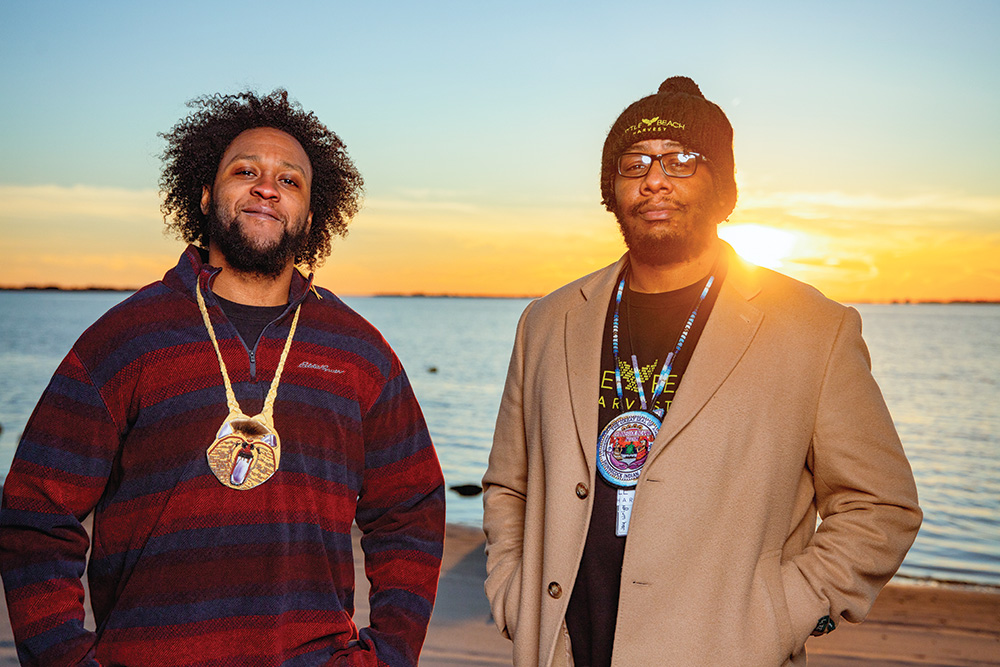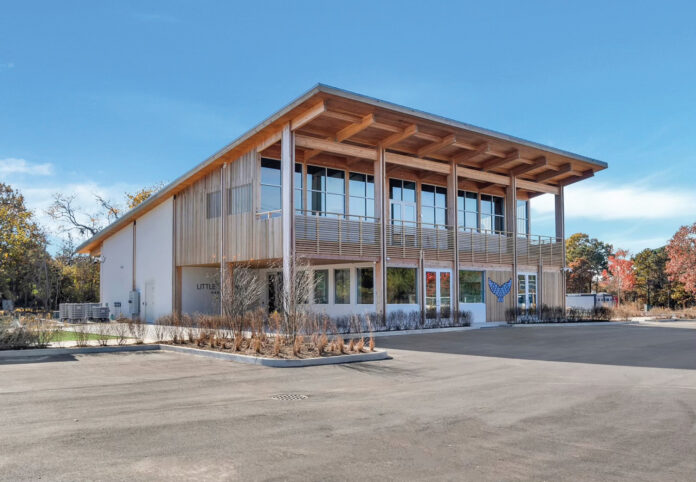The Shinnecock Nation is one of the oldest self-governing tribes in New York state, so it’s only fitting the people became the first to operate a tribal-owned dispensary in the Eastern Long Island region. Opened in 2023 and licensed by the Shinnecock Cannabis Regulatory Division, vertically integrated Little Beach Harvest is a testament to the resilience of the Shinnecock Nation and its members. The dispensary’s spatial design and organic aesthetics are a reflection of the tribe’s values and culture.
Characterized by wood cladding and large glass windows, the building encompasses about 6,000 square feet and boasts a bright, natural, and comfortable atmosphere. The large wood-framed structure features a sloped, shed-type roof that imbues the building with a modern vibe and maximizes the natural light entering the building.
The interior, also lined with light-colored raw wood, is decorated with beadworks, jewelry, and a collage of images photographed by tribal members. The photos depict a wide variety of valuable plant medicine found in the local area, from cedar and sage to cannabis.
The images display “all the things that encompass what we’ve used traditionally as medicine here,” said Sean Boyd, a Shinnecock tribal member and brand specialist for the store.
While the cultural and traditional-medicine tidbits are integral to the dispensary’s big picture, they’re not the main focus.
“At the end of the day, we are selling medicine — cannabis — more than we are selling our culture,” Boyd said. “We are a business, and our business isn’t to sell our culture. It’s to offer plant medicine and provide an experience. But we also want to remind visitors of where they are and the space they’re stepping into.”
Located on tribal land in the present-day Hamptons, the store enjoys significant traffic during the spring and summer months when vacationers are abundant; traffic slows down during the off-season. Regardless of the time of year, though, the dispensary’s design reflects a “Hamptons summertime” aesthetic with its open layout, natural light, extensive space, and airy displays.
The name Shinnecock roughly translates to “people of the stony shore,” hence the natural stone flooring and other design features that elicit a seaside ambiance. Flow is a key aspect of the store’s floor plan, as it reflects the tribe’s ever-evolving nature while also calling out the beachside location.

“We have lots of flowing things, like tall glass display cases,” said Jay Wright, a Shinnecock citizen and product marketing manager for Little Beach Harvest. “We have shells and lots of beach scenery to flow in with everything.”
The dispensary’s massive size stands out from the everyday cannabis-shop experience. Two-story-high ceilings catch customers’ attention immediately upon entry. Wright explained the team can always tell when it’s a person’s first time visiting, because their gaze travels upward to take in the sheer volume of the space.
“Rays of sun shine through the building for natural lighting,” Wright said. “Everything about this building is natural, because that’s who we are as a people and what we’ve always been accustomed to.”
While the top floor of the building currently is used as an office for the team, work is underway to convert the space into a consumption lounge and events venue. (Little Beach already has hosted several events, from live musical performances to cookouts and art exhibits featuring Shinnecock and Long Island artists.)
In addition to the curated art pieces sprinkled throughout the sales floor, Little Beach also incorporates a twelve-foot mural: a live painting gifted from a local Shinnecock artist and cultivator known as Taboo. Wright and Boyd said visitors regularly ask about the mural, providing an opportunity for the team to support and uplift their community. Taboo’s brand, Peshaun Exotic Flowers, is on the shelves at the store.

“This building has a lot of community involvement inside of it,” said Wright. “We don’t care if guests even end up buying something as long as they leave with a piece of knowledge and understanding about where they are and who’s in their area. That’s what we’re aiming for.”
Boyd and Wright explained the importance of disparate groups bonding over the plant’s vast potential. While the two men are proponents of medicinal use, they also advocate for cannabis bringing people together socially and opening doors for artistic expression and the free-flowing exchange of ideas. The two explained they often push back against the stigma associated with cannabis use, especially among tribal communities. The store’s design plays a crucial role in challenging preconceived notions about what it means to be someone who uses cannabis.
A recent Gallup poll found 15 percent of Americans identify as cannabis smokers, consistent with an overall upward trend in recent years. Despite the plant’s growing acceptance and accessibility, stigma can carry a lot of weight in tribal communities. A key aspect of Little Beach Harvest’s design is the creation of a safe, comfortable space for customers from all walks of life to explore.
“I can’t even tell you how many times people have asked us when we’re going to put up a casino,” Wright said. “The stigma that [indigenous] people just get drunk or gamble—that’s what we’re trying to break down. We can do other things. That’s what this building means to us.”
Little Beach Harvest’s team also was intentional when they created large, open displays that don’t overwhelm or intimidate visitors.
“There isn’t just cannabis everywhere,” Boyd said. “It’s there when you look for it, but it’s not very bold or in your face. Customers come up to our budtenders and ask for knowledge, seek knowledge, and receive knowledge in a way that’s different from some other dispensary experiences.”
Wright explained many of the dispensary’s customers are either novices or haven’t engaged with the plant for decades. These types of consumers often don’t know where to start on their personal journey.
“Having nice, open, comfortable sceneries and displays that are meaningful to what people are looking for and curated the right way gives people a sense of ease,” Wright said.
While plenty of customers may seek a sense of ease and access to education, Little Beach Harvest also welcomes customers who know exactly what they like and prefer an in-and-out experience. For this demographic, kiosks are a handy tool for quick selection and checkout. For an even quicker experience, customers may also utilize the store’s drive-thru window.
“We have early-morning rushes with people who are on the go and don’t want to get out of the car,” said Wright, adding that such customers may place an order on their phone and pick up their selections at the drive-thru shortly thereafter. “It’s all about keeping it sleek, fresh, and intuitive.”
Keeping things fresh and adapting to needs are recurring themes for the dispensary and the indigenous nation behind it. Both qualities are deeply embedded in the Shinnecock people, who have resided on Long Island for thousands of years. The tribe’s evolution has not been easy, Boyd and Wright admitted, but the tribe is strong and resilient. For the Little Beach Harvest team, the mere existence of the dispensary is a powerful reminder of the people’s vigor.
“The building itself, the whole process of getting this structured and done, is a testament to the resilience of our tribe,” said Boyd. “It’s a testament to staying true to our culture, to preserving what it is to be Shinnecock, which changes over time. It changes in situations. But at the end of the day, who we are—the people—that doesn’t change. That’s what we wanted to establish within this building.”
He explained the Shinnecock people have always been community-centered, so creating a building that serves as a community hub was only natural.
“This project and the idea of us moving forward as a people resonates within this building and within the culture of this company,” Wright said.
The building’s open floor plan also highlights the values of the Shinnecock people. Boyd described his tribe as “very open and hardworking. The whole idea of the building being open and free flowing was there from the beginning. We are resilient, steadfast, and everchanging and growing. We have been here since the founding of this town.”

Although Boyd and Wright care deeply about their tribal community, they are also dedicated to the larger Southampton and cannabis communities.
“Yes, we are Shinnecock members, but we’re also members of the larger community,” Boyd said. “We went to Southampton High School, and we grew up in this town.”
Consequently, when the Little Beach Harvest team began to develop the dispensary, they sought input from all stakeholders to inform the plan. Setting a structure that reflected sometimes-diverse values was important to the team, as they knew the interior could always change and adapt, but the exterior would be permanent.
“We were blessed with this building, and then we had this freedom where we could curate it on the inside in different ways as we change through the seasons and with our customers,” said Boyd. “We’re fortunate that the building is beautiful and does its job in attracting people here.”
Little Beach Harvest’s strong presence in the community, large building, and open interior design act as powerful symbols and a reminder that the Shinnecock remain a growing, autonomous nation with its own territory and ancestral traditions. Even the building’s location tells a compelling story of resilience.
“Right in front of our building is a foundation of a building that was once an opportunity to encroach on our land, not too long before there was structural and economic development on the front side of the territory,” Boyd said. “Builders wanted to take parts of our land to do what they wanted with it. And it took a group of elder women and the support of the community to go out there and protest, to fight for our land and establish a solid boundary.”
The story almost had been forgotten until development for the dispensary began. When a bulldozer preparing the site for the next chapter in Shinnecock history uncovered the buried remains of the old battleground, it seemed a fitting coda for the attempted betrayal.
“We rediscovered that foundation, and we left it there as a sign and remembrance of what it took us to be able to actually build this and to be here,” Boyd said. “And the fight that our ancestors put up for us. The fight that we continue to take forth to exert our sovereignty.”










